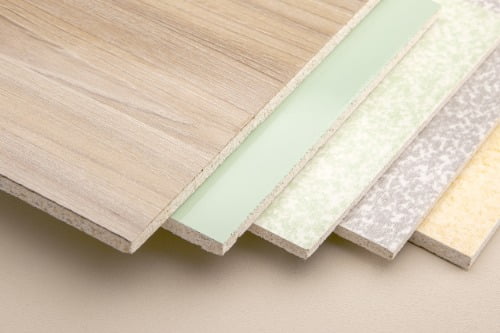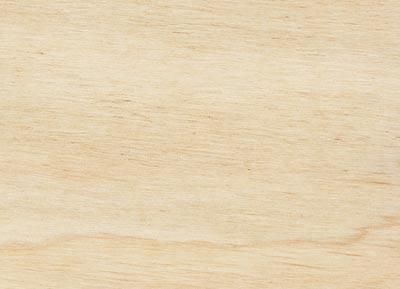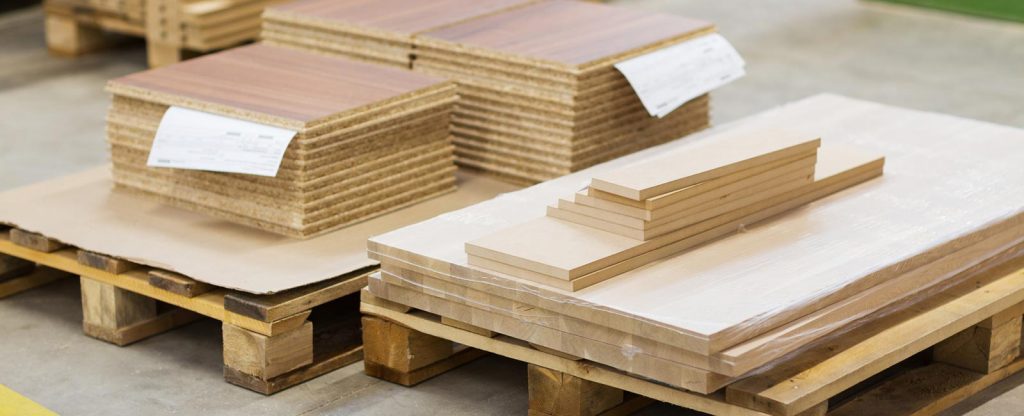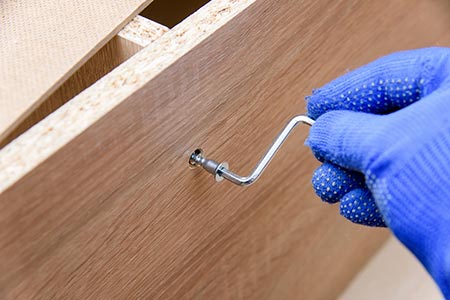It’s easy to think of MDF and plywood as the same thing when you see them in the home improvement section of your local store. But they could not be more different. Where the strength of one is the weakness of another. So when it comes to MDF vs plywood, is there a better choice?
Find out the differences between the two and where best to use them.
What is MDF?
Medium Density Fibreboard or MDF is an engineered wood composite.

When creating MDF, manufacturers break wood down into basic fibre or fibre lumps. For this reason, the particular species of wood, straightness, knottiness, etc. are not important. This allows manufacturers to source cheaper MDF raw materials and keep the overall costs low.
The fibres are then combined with an adhesive and pressed together under heat. The heat is what cures the adhesive while making the fibres pliable during pressing.
You can purchase MDF in a variety of thicknesses and grades. It’s the material typically used in ready-made furniture, cabinets, shelves in storage units and decorative wall cladding.
Characteristics of MDF:
- No visible wood grains or knots; smooth, uniform material throughout (including surfaces and cut edges)
- Lighter than plywood
- Tends to cost less than most types of plywood
- Thick, high-quality MDF can bear great weights without bending or “bowing”
- Easy to cut; resulting edges are smooth and do not splinter
- A great substrate; easy to laminate, veneer or lacquer
- Its surface is smooth and absorbs some paints well (e.g., aerosol spray primers); perfect for quality primers with oil as a base
Disadvantages:
- Soaks up water or moisture like a sponge
- If exposed to water and variations in temperature, MDF easily expands (and eventually splits)
- Impact resistance is generally lower than that of plywood; forms noticeable surface dents
- Unable to hold screws in place for long periods
- Bonding agents contain low concentrations of formaldehyde
We are a wholesale MDF supplier and stock a large range of MDF. This ranges from standard grade to moisture resistant, fire retardant, melamine overlay and timber veneered MDF boards.
Plywood

Plywood is a wooden panel made by putting together several thin layers of wood veneers to create a solid piece. The layers can be different types of wood.
Check out our article on how plywood is made.
Depending on the grade, plywood is best for use in the construction of homes, boats, floors, walls, and ceilings. Higher grades are also suitable for making cabinets.
Because of the different treatments of plywood, it can serve for interior, exterior and even marine construction purposes.
Characteristics of Plywood:
- Very durable building material; the grain on each veneer layer runs in different directions to bolster plywood strength
- Looks more like real wood; has the appearance of solid wood
- Resistant to water damage; won’t soak up as much water nor swell and warp as easily as MDF
- Perfect for minimal staining as a finish
- Holds screws tightly
- High-quality thick plywood is a good material for subflooring and walls; it can be laminated, veneered, lacquered or micro-cemented
- Most of today’s plywood is formaldehyde-free
Disadvantages:
- Heavier than MDF
- Tends to be more expensive than MDF; the higher the grade, the pricier it gets
- Cutting exposes some sharp edges; also tends to form splinters when cut
- Difficult to cut into intricate design details
We supply a huge range of plywood and can usually custom prepare and treat plywood to your specific purposes. All our plywood is 100% sourced from local Australian plantations. It is also guaranteed renewable and certified with a zero formaldehyde emission rating.
MDF or Plywood — Which one should you use?
Decide which one to use for your project based on your budget and the application.
If you have no specific preference and you’re just thinking about cost, MDF is generally cheaper. But if better moisture resistance, durability or strength is what you’re after, the best plywood still wins hands-down over the best MDF.
You can keep costs down by using MDF for wall panelling, decorative trims, mouldings, and light furniture. Bear in mind that since it does not handle moisture very well, MDF should only be used for interiors. It is also a better choice for applications that require specific shaping, cutting and drilling since it does not splinter like plywood. And if you are going to use paint, MDF is also a great choice for a smooth surface.
However, for the construction of doors, stairs, ceilings, roofs, floors and exterior features, it’s better to use plywood. Make sure to use the appropriate type of plywood for your purpose. When manufactured and treated, plywood holds up quite well to water exposure. It can also handle heavy loads, so it is an appropriate material for framing walls or heavy-duty cabinets (e.g., kitchen storage).
Still deciding to go with MDF vs plywood or vice versa? Let FA Mitchell walk you through your options and give you expert advice on the best plywood or MDF to use for your next commercial project. We’re one of the best plywood panels and MDF board suppliers to the trade, builders and specifiers in Sydney and around Australia.
Contact us now for a consultation.




